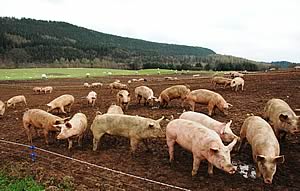13/12/07
The general picture reported by NADIS veterinary surgeons
for pig farms in November suggested that herds are starting
to come out of problems imposed by movement restrictions
due to FMD and the gradual restoration of meat exports
is at least allowing herds to cull sows as needed. There
was, however, a wide range of problems reported, particularly
in breeding stock.
Gilts
Health and acclimatisation of incoming gilts featured in
a number of reports with the familiar pattern of gilts
entering a farm to healthy and suffering subsequently.
Attention to vaccination regimes prior to delivery was
important in addition to avoidance of excessive challenge
on arrival. In one instance looking back through the
year, approximately 15% of supplied gilts had failed
to breed – requiring culling – as a result
of health challenge.
Recent reports of gilts failing to
cycle properly was also consistent with autumn infertility,
which had been anticipated following a summer of poor
light levels.
Sows
A number of reports suggested sow mortality has been high
in recent months and in most cases this appears to be the
result of a failure to cull due to marketing restrictions.
Either sows have become overcrowded as culls have not left
the farm – leading directly to more injuries requiring
euthanasia, or herds have tended to destroy sows that might
in the past have been kept to allow recovery before culling.
Infertility was prominent in the monthly reports which
relates to sows served from August onwards. Many of these
have been assigned to seasonal infertility, although in
one case mouldy straw was to blame and in another an infectious
infection process (possibly influenza) was thought to have
accounted for a dramatic rise in returns.
2nd litter drop was reported as a result of the combined
effects of gilts performing extremely well (rearing 11
pigs/litter) and bullying of weaned gilts in yards when
mixed with the next group.
Piglets
Very few specific problems were reported in sucking piglets
in November. A high stillbirth rate recorded on one farm
was thought to be more to do with inaccurate recording – pigs
born alive but dying very early. This has implications
as to corrective measures.
Scour, as usual, featured with
coccidiosis, clostridia and rotavirus reported. Given the
widespread use of anticoccidial treatments on pig farms,
the continued problems with coccidiosis is perhaps surprising.
It should be noted that the timing of the use of Baycox
(Bayer) is critical if it is to give lasting protection.
When given to pigs below 96 hours of age its effect can
be erratic. Ideally it should be given to piglets between
96 and 120 hours of age.
Weaners
Weaner problems were quite sparse within reports although
anecdotal comments are coming through from farms using
Circovirus vaccines. One of the earliest farms to start
this vaccination (in sows), having seen dramatic initial
improvements, has started to see an increase in fading
pigs after weaning, coinciding with a 0.75 rise in pigs
weaned/litter. Inadequate colostrum intake in larger litters
at birth was thought to be at the root of this problem.
Chilling
problems as a result of variable night time temperatures
and inadequate adjustment of air inlets etc was prominent,
and in one case a dramatic tail biting problem over the
preceding month was ascribed to poor adjustment of air
inlets in a newly commissioned building – an unfortunate
case of stockmen expecting a ‘new’ building
to work perfectly without need for their input.
Finishers
Overstocking in finishing pigs was widely reported with
a number of factors contributing.
- Delays and rollover
at slaughter as demand for pig meat declined with the
loss of exports in September/October. Farms are still
trying to catch up on expected slaughterings. Attempts
to reduce slaughter weight have been frustrated by the
build up of pigs.
- Overserving earlier in the year to compensate
for infertility problems which then corrected, leading
to excessive farrowings (hence too may pigs) which also
impacts on weaning age and weight, slowing subsequent
growth and causing overstocking.
- Improvements to health
as a result of implementation of Circovirus vaccination,
which is having a dramatic effect on mortality levels,
with some farms seeing drops of 5-8 percentage age points.
These surviving pigs risk overcrowding on the farm.
Problems reported that have been blamed on
overcrowding include:
- Increased pneumonias
- Late onset PMWS/PDNS
- Riding injuries
In addition to these problems, enteric
disease was prevalent and included colitis/ileitis, occasional
cases of Swine Dysentery and one report of acute Salmonellosis
causing a severe scour in growing pigs. Gastric ulcers
also continue to feature in reports of sporadic on farm
post mortem examination.
As we head into winter problems
might be anticipated with:
- Respiratory disease in low
air flow environments
- Interruptions to water supply
- Continued difficulties
resulting from overcrowding
- Slowed growth as producers
are tempted to cut feed costs by using cheaper or less
suitable rations
Mark White BVSc DPM MRCVS
 NADIS Pig Health Report for October 2007 NADIS Pig Health Report for October 2007
 Heavier Pigs Hitting The Market Heavier Pigs Hitting The Market
 Avoid Temptation to Retain Old Sows Avoid Temptation to Retain Old Sows
|



